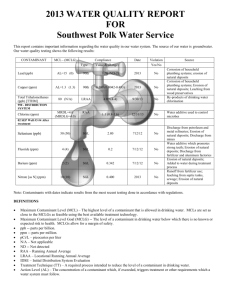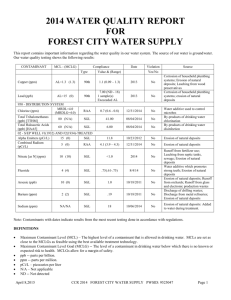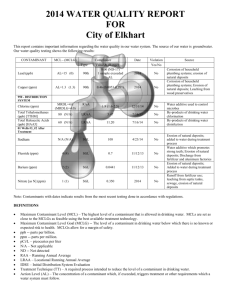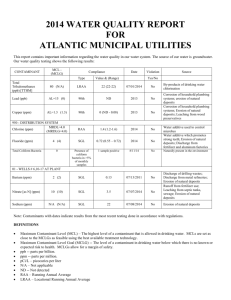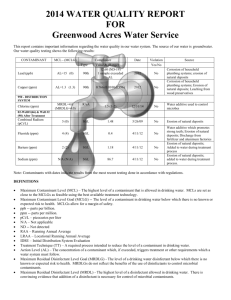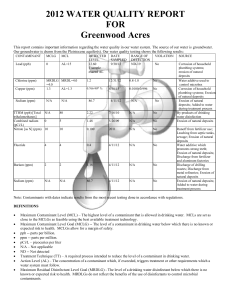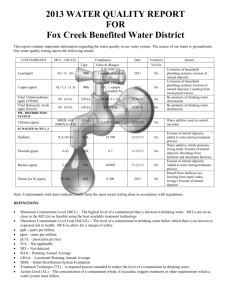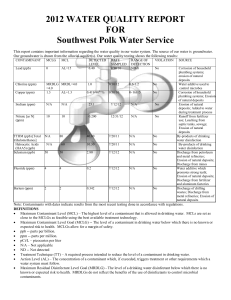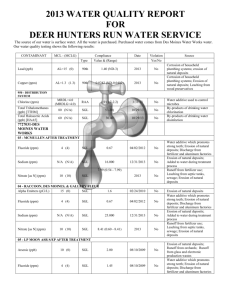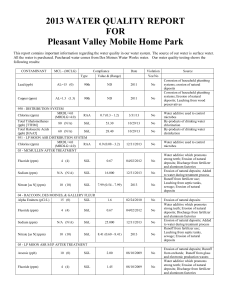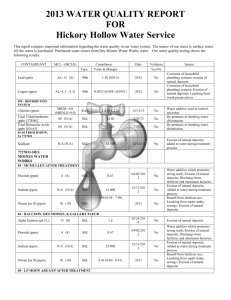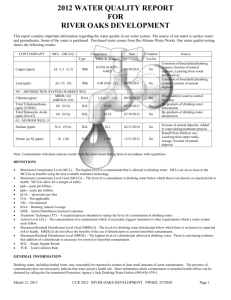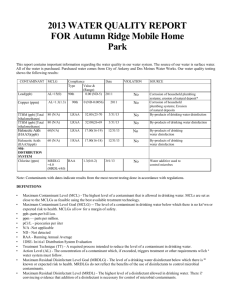2014 CCR
advertisement
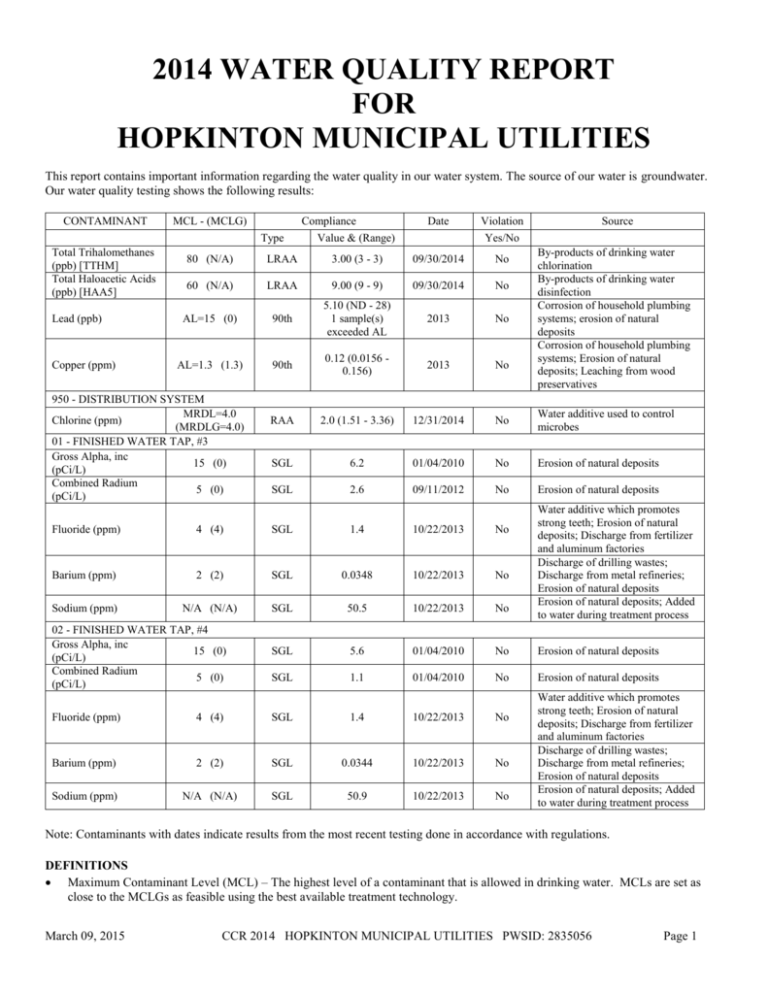
2014 WATER QUALITY REPORT FOR HOPKINTON MUNICIPAL UTILITIES This report contains important information regarding the water quality in our water system. The source of our water is groundwater. Our water quality testing shows the following results: CONTAMINANT MCL - (MCLG) Type Total Trihalomethanes (ppb) [TTHM] Total Haloacetic Acids (ppb) [HAA5] Lead (ppb) Copper (ppm) Compliance Value & (Range) Date Violation Yes/No Source By-products of drinking water chlorination By-products of drinking water disinfection Corrosion of household plumbing systems; erosion of natural deposits Corrosion of household plumbing systems; Erosion of natural deposits; Leaching from wood preservatives 80 (N/A) LRAA 3.00 (3 - 3) 09/30/2014 No 60 (N/A) LRAA 9.00 (9 - 9) 09/30/2014 No AL=15 (0) 90th 5.10 (ND - 28) 1 sample(s) exceeded AL 2013 No AL=1.3 (1.3) 90th 0.12 (0.0156 0.156) 2013 No RAA 2.0 (1.51 - 3.36) 12/31/2014 No Water additive used to control microbes SGL 6.2 01/04/2010 No Erosion of natural deposits SGL 2.6 09/11/2012 No Erosion of natural deposits 950 - DISTRIBUTION SYSTEM MRDL=4.0 Chlorine (ppm) (MRDLG=4.0) 01 - FINISHED WATER TAP, #3 Gross Alpha, inc 15 (0) (pCi/L) Combined Radium 5 (0) (pCi/L) Water additive which promotes strong teeth; Erosion of natural deposits; Discharge from fertilizer and aluminum factories Discharge of drilling wastes; Discharge from metal refineries; Erosion of natural deposits Erosion of natural deposits; Added to water during treatment process Fluoride (ppm) 4 (4) SGL 1.4 10/22/2013 No Barium (ppm) 2 (2) SGL 0.0348 10/22/2013 No Sodium (ppm) N/A (N/A) SGL 50.5 10/22/2013 No SGL 5.6 01/04/2010 No Erosion of natural deposits SGL 1.1 01/04/2010 No Erosion of natural deposits 02 - FINISHED WATER TAP, #4 Gross Alpha, inc 15 (0) (pCi/L) Combined Radium 5 (0) (pCi/L) Fluoride (ppm) 4 (4) SGL 1.4 10/22/2013 No Barium (ppm) 2 (2) SGL 0.0344 10/22/2013 No Sodium (ppm) N/A (N/A) SGL 50.9 10/22/2013 No Water additive which promotes strong teeth; Erosion of natural deposits; Discharge from fertilizer and aluminum factories Discharge of drilling wastes; Discharge from metal refineries; Erosion of natural deposits Erosion of natural deposits; Added to water during treatment process Note: Contaminants with dates indicate results from the most recent testing done in accordance with regulations. DEFINITIONS Maximum Contaminant Level (MCL) – The highest level of a contaminant that is allowed in drinking water. MCLs are set as close to the MCLGs as feasible using the best available treatment technology. March 09, 2015 CCR 2014 HOPKINTON MUNICIPAL UTILITIES PWSID: 2835056 Page 1 Maximum Contaminant Level Goal (MCLG) -- The level of a contaminant in drinking water below which there is no known or expected risk to health. MCLGs allow for a margin of safety. ppb -- parts per billion. ppm -- parts per million. pCi/L – picocuries per liter N/A – Not applicable ND -- Not detected RAA – Running Annual Average LRAA – Locational Running Annual Average Treatment Technique (TT) – A required process intended to reduce the level of a contaminant in drinking water. Action Level (AL) – The concentration of a contaminant which, if exceeded, triggers treatment or other requirements which a water system must follow. Maximum Residual Disinfectant Level Goal (MRDLG) - The level of a drinking water disinfectant below which there is no known or expected risk to health. MRDLGs do not reflect the benefits of the use of disinfectants to control microbial contaminants. Maximum Residual Disinfectant Level (MRDL) - The highest level of a disinfectant allowed in drinking water. There is convincing evidence that addition of a disinfectant is necessary for control of microbial contaminants. SGL – Single Sample Result TCR – Total Coliform Rule GENERAL INFORMATION Drinking water, including bottled water, may reasonably be expected to contain at least small amounts of some contaminants. The presence of contaminants does not necessarily indicate that water posed a health risk. More information about contaminants or potential health effects can be obtained by calling the Environmental Protection Agency’s Safe Drinking Water Hotline (800-4264791). Some people may be more vulnerable to contaminants in drinking water than the general population. Immuno-compromised persons such as persons with cancer undergoing chemotherapy, persons who have undergone organ transplants, people with HIV/AIDS or other immune system disorders, some elderly, and infants can be particularly at risk from infections. These people should seek advice about drinking water from their health care providers. EPA/CDC guidelines on appropriate means to lessen the risk of infection by Cryptosporidium and other microbial contaminants are available from the Safe Drinking Water Hotline (800-426-4791). If present, elevated levels of lead can cause serious health problems, especially for pregnant women and young children. Lead in drinking water is primarily from materials and components associated with service lines and home plumbing. HOPKINTON MUNICIPAL UTILITIES is responsible for providing high quality drinking water, but cannot control the variety of materials used in plumbing components. When your water has been sitting for several hours, you can minimize the potential for lead exposure by flushing your tap for 30 seconds to 2 minutes before using water for drinking or cooking. If you are concerned about lead in your water, you may wish to have your water tested. Information on lead in drinking water, testing methods and steps you can take to minimize exposure is available from the Safe Drinking Water Hotline or at http://www.epa.gov/safewater/lead. ADDITIONAL HEALTH INFORMATION Infants and young children are typically more vulnerable to lead in drinking water than the general population. It is possible that lead levels at your home may be higher than at other homes in the community as a result of materials used in your home's plumbing. If you are concerned about elevated lead levels in your home's water, you may wish to have your water tested and flush your tap for 30 seconds to 2 minutes before using tap water. Additional information is available from the Safe Drinking Water Hotline (800-4264791). SOURCE WATER ASSESSMENT INFORMATION This water supply obtains its water from the sandstone and dolomite of the Cambrian-Ordovician aquifer. The Cambrian-Ordovician aquifer was determined to have low susceptibility to contamination because the characteristics of the aquifer and overlying materials provide natural protection from contaminants at the land surface. The Cambrian-Ordovician wells will have low susceptibility to surface contaminants such as leaking underground storage tanks, contaminant spills, and excess fertilizer application. A detailed evaluation of your source water was completed by the Iowa Department of Natural Resources, and is available from Hopkinton Municipal Utilities office at 563-926-2480. CONTACT INFORMATION For questions regarding this information or how you can get involved in decisions regarding the water system, please contact HOPKINTON MUNICIPAL UTILITIES at 563-926-2480. March 09, 2015 CCR 2014 HOPKINTON MUNICIPAL UTILITIES PWSID: 2835056 Page 2 March 09, 2015 CCR 2014 HOPKINTON MUNICIPAL UTILITIES PWSID: 2835056 Page 3
